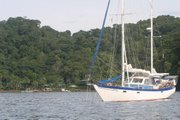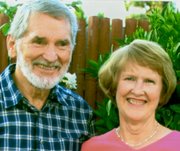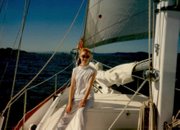Today we would begin our only long passage, from here to Bahía Piñas, in the Darién, Panamá. So, not needing to reach a destination that day before dark, we were in no particular hurry to get going, We breakfasted leisurely, out with our binoculars trying to locate the birds we could hear. Their sounds reminded Bob of those of the cocks-of-the-rock we’d seen in the Andes of Ecuador, but we thought they were more likely coming from toucans of one of the many varieties in Ecuador. The only birds visible were the hundreds of roosting brown pelicans in the branches of the trees closest to the water.
At 0800 we hoisted, now in 11 feet of water, and motored farther north past the city of Atacames, similar in appearance to Salinas, Ecuador, with numerous high-rise hotels and condos and the fishing port spread along the 3-mile beach.
Then we headed offshore, setting our course for Bahía Piñas, Panamá, 402 miles northward. Once again, we were on fish net buoy alert. About 10 miles offshore, two pangas appeared on the horizon, speeding toward us. We checked the ocean surface all around for any signs of nets but saw none. Still they sped our way. We had a slight bit of apprehension, wondering who they were and what they were doing so far offshore if not fishing. They seemed aimed for a direct hit on our beam, but both veered off at the last minute, waving and shouting cheerily to us. Obviously, they were among the four to six pangas that many of the fishing trawlers tow behind them like a string of duckies as they head out to sea. We couldn’t see the mother ship, but it had to be nearby.
More alarming was a second incident when our course had taken us about 20 miles from our last anchorage but to within 60 miles of the Colombia coast. Bob had gone down to sleep in preparation for the night watches, when two pangas again came speeding over the eastern horizon, identifiable initially by the white water splashing. But instead of continuing toward us, they stopped ahead about a mile, as if waiting. I could see three figures in each boat. After sitting there a few minutes, they headed toward us. Oh, dear, this did look ominous. I called down for reinforcements as we sailed steadily on at about 7 knots. Bob rushed up in time to see the two pangas swerve behind, once again waving and calling merrily, before disappearing over the western horizon.
When a pod of spinner dolphins began creating white water all around us a bit later, we had no apprehensions at all—just big smiles. We’d not been visited by these graceful creatures for a long time. Gray-hooded gulls, pintado petrels, Nazca boobies, and least storm petrels filled out the bill of entertainment until sundown.
During the night, I came on-deck for my 0200 watch to find Bob rather than Alphy, the autopilot, steering. Once again, our recently troubled helper had failed us. Without sufficient wind to use the wind vane, we hand steered in turn until 0600, when the winds rose from 2 to 10 so Vanna the Vane would function.
This day was the most gorgeous we’d had for awhile: no marine layer but fresh breezes. One rain cell passed over us briefly, washing off the decks. Then the sun shone brightly for the remainder of the day. The water temperature had now risen from a cool 74° to 84°.
At about 1400, when we were parallel with Buenaventura, Colombia, a U.S. Coast Guard plane did the two low flyovers we’d had from the helicopter, but no frigate followed. Guess we were even less suspicious looking this time.
At dark, the wind had died so that Vanna was wandering wildly. Bob set up the rather complex and fussy auxiliary autopilot/vane combination that doesn’t rely on wind but electrically controls the rudder through Vanna’s system. (Silly us. We call this vane “Vanita.” Our only excuse for such silliness is that “Vanita” is much easier to say than “the auxiliary steering vane.” But it may also be these pieces of equipment seem to share certain qualities with people. We become particularly fond of those that give us little grief.)
The following morning the USCG plane gave us another pass as we trudged along, making only 4 knots good over ground because of the adverse current. But it passed over only once. Apparently we’re gaining ever more acceptance as a legitimate pleasure craft.
Despite our lack of speed, the day’s sailing in light southwest winds and long sinuous 6-foot swells was a delight. But the conditions changed during the night, when we’d apparently reached the southernmost limit of the ITCZ, with winds now from the northwest.
We motorsailed throughout the following day and made good time, covering 140 miles in the 24-hour period despite the uncomfortable conditions. We missed several rain cells that loomed on the horizon, but one enormous black cloud caught up to us. Once I’d determined the cell was not going to miss us, as had the others, I reluctantly awoke Bob, who was getting some much needed sleep. I should have awakened him a few minutes earlier, for the storm, bringing 40-45-knot winds and torrential rains, was upon us before we could get the mainsail down. Bob played with the mainsail sheets while I steered. The storm quickly passed over us, and crew and equipment survived intact.
The next cell followed shortly after, with only 8-12-knot winds but lightning all around the boat and, again, torrential rains. We unplugged all the electronic and electrical equipment, gritted our teeth, and plowed on through, counting the steadily diminishing seconds between the flash and the thunder.
Such heavy rain did have the benefit of flattening the seas somewhat, but it also identified leaks in the dodger we hadn’t known we’d had. Or maybe that’s a good thing, too. Now we can try to seal the holes.
The intervals between lightening and thunder began to increase after about an hour, but the heavy rain continued for three hours. We can’t remember when we’d last been so happy to reach a port as when we rounded the rocks at the entrance of Bahía Piñas, in Panamá. We anchored about 150 feet from shore in about 34 feet to be clear of the moorings of the Tropic Star Lodge, a pricey fishing lodge, the only one in the Darién.
We had quite a bit of swell, but they were only uncomfortable at times, not dangerous, so we could rest peacefully, though we had to sleep in the main saloon rather than aft in our bunk. Bob was feeling well, though he still had a cough, but I had felt increasing ill with each day. Apparently we had picked up a virus in Manta rather than an allergy in Pasado.
The next morning we took Abby ashore. The reports we’d heard about the lodge were that cruising sailors were not particularly welcome. We motored around the beautiful sturdy dock, longing to tie Abby there rather than make a beach landing. As we circled around hesitantly, two young men came rapidly down the dock from shore, and we said, “Oops. We’re going to be told to stay away from the lodge docks.”
But instead, they motioned us to come to the dock, where one of them took our line, tied it to the cleat, and then put out a hand to help me up onto the dock. We asked if we could leave the sportboat there while we explored ashore, and they said, “Claro.”
At the head of the dock, Hennie, the South African who manages the lodge, met us to welcome us to explore the grounds and the facilities and generally to make ourselves at home. Visiting sailors, he said, are welcome to tie up at the docks and explore the grounds, though if the lodge is filled, as it will be between December and May, the restaurant and other facilities may not be able to accommodate these additional visitors. So much for the rumor mill!
When we met Ursula, Hennie’s wife, she suggested we might want to ride over to the neighboring village of Piñas with the lodge panga that afternoon to see the village and possibly purchase native crafts from the local Emberá or Wounaan people. The panga would return to pick us up two or three hours later. Charlie, an American, and former cruising sailor, whom we’d met as we walked around the grounds, offered to ask his wife, a Panamanian who had been teaching elementary school in the village when he met her to go with us to show us around.
Lisbet, his wife, did indeed accompany us to the village, where she was treated by all the villagers as visiting royalty, children and adults alike calling out, “Maestra, Maestra!” as we walked by. The first section of the village was modern looking, with small stuccoed houses, their bright paint chipped and fading with time. Beyond the school, incontestably the spiffiest structure in Piñas, the architecture changed. Now we were walking down narrow dirt streets and footpaths past traditional dwellings, large wall-free platforms on stilts under a thatch roof. The only “furnishings” we could see were hammocks and woven reed mats, with an occasional small room defined by these hanging mats.
At one of these homes a young man and woman brought out a plastic bag of woven reed masks and platters, which Lizzie described as the best quality in the village. We purchased a stylized wolf mask to add to our collection of Mexico and Costa Rica masks and a large woven platter with intricate animal and geometric designs, a well as a smaller oval plate, with a scorpion in its center.
The panga driver had taken us up the Rio Piña at high tide so we could disembark in calm water. When he picked us up again two hours later, the tide was too low for the panga to cross the bar at the mouth of the river. The driver, alone in the panga, expertly backed the 40-foot panga through the wild surf, breaking at about 4 feet high, raised the motor, and kept the panga in position with a single paddle. We climbed into the panga, getting wet only up to our knees, and he just as expertly maneuvered the boat back through the breaking surf. We hugged our cameras to our chests to protect them from the inevitable breaking wave across the bow. We got nary a drop of water inside the boat. Amazing! We’d never hesitate to make beach landings if we had his skills. We wonder how many drenchings he’d had in training.
As we’d waited on the beach for the panga to arrive, we watched just such a training session as he must have had. Two young boys from the village, perhaps 10-12 years old, were launching a narrow dug-out canoe through this same surf. They filled the canoe a couple of times, hastily scooped out the water with a plastic bottle, its top cut off. But, after about 10 minutes, they successfully navigated through the surf to join two other groups of boys in canoes already beyond the surf and seemingly greatly entertained by the travails of these latest canoeists. Of course, you already understand that none of these boys, a mile or so away from any adult supervision or assistance, wore lifejackets.
In the evening Charlie and Lizzie came out for drinks and a visit, and we made plans to get together with them after the holidays, when they’ll both be home in Panamá City. Charlie had owned a small fiber-optics gyroscope company in the U. S.—one of his gyros is on some equipment on Mars—before selling out to go cruising about ten years ago. Now he says he’s home. Lizzie has much to say about public education in Panamá, as well as many hints about sights to see in Panamá.
On Monday, our last day in Bahía Piñas, we went ashore to hike up the hill behind the lodge to see if we could spot the three-toed sloths, the harpy eagle nest, and the white eagle reported by Hennie and Charlie. But the trail was quite steep, and muddy and slippery, and I was still not wholly over the virus, not to mention the ever-present cranky back. We’ll try this potentially wonderful hike another time.
Thursday, November 30, 2006
Subscribe to:
Post Comments (Atom)






No comments:
Post a Comment